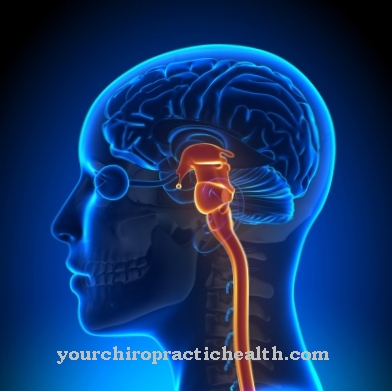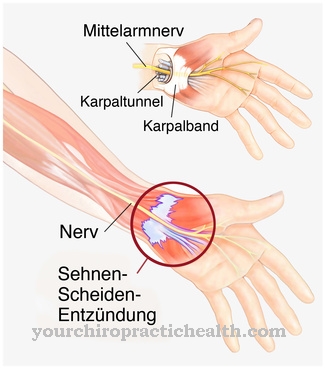The Osteonecrosis refers to the death (necrosis) of bones or sections of bone due to an infarction of the bone.Bone necrosis can occur at any age. The prognosis of osteonecrosis ranges from complete healing to complete destruction of the respective bones, depending on the location of the disorder.
What is osteonecrosis?

© VectorMine - stock.adobe.com
A Osteonecrosis is characterized by severe pain in the affected area. There are three types of osteonecrosis.
These include the aseptic, septic and post-traumatic forms. While septic osteonecrosis is triggered by an infection, the aseptic form is a collective term for all necrosis of the bone that is not caused by an infection.
Post-traumatic osteonecrosis occurs after an injury or fracture of the bone and can be triggered by an infection or other processes that follow the trauma. Every form of osteonecrosis is directly caused by the closure of a blood vessel that supplies the respective bone.
causes
If the supply of nutrients to a bone or a section of bone is interrupted, it dies or, in other words, it dies Osteonecrosis.
The only immediate cause of this undersupply is to be found in the disruption of the blood flow in the area concerned. How the occlusion of the blood vessel occurs, however, must be clarified in each individual case. Both infectious and non-infectious processes can precede this event. Furthermore, the triggering factor can be an injury at the relevant point. The occlusion of the blood vessel can also occur as a result of other diseases, such as B. by hemoglobinopathies (blood diseases).
Furthermore, biophosphonates, which are used as drugs to treat osteoporosis, are a risk factor for osteonecrosis in the area of the jawbones. Among other things, they inhibit the formation of new blood vessels in the bone tissue, so that the jawbones then become particularly susceptible to osteonecrosis when exposed to further stress.
Symptoms, ailments & signs
Osteonecrosis initially manifests itself as pain, which can vary depending on the severity and location of the necrosis. This can lead to bone pain and joint pain, but also to tension pain and nerve pain as a result. Initially, the pain only occurs with physical exertion, before it develops into a chronic complication.
In some patients, joint effusion occurs as a result of the necrosis. This is associated with pulsating pain and tenderness in the affected area. The skin initially feels overheated before the body temperature drops as a result of the decreased blood flow. Then the necrosis occasionally also show up externally, usually in the form of dark swellings.
Small defects often heal by themselves. Large areas of necrosis usually affect other parts of the body and destroy bones and joints in the process. The disease is often accompanied by sleep problems, personality changes and depression. In most cases, the patient can also no longer move as smoothly as before.
The bone necrosis takes a progressive course and increases in intensity. If it is treated early, long-term consequences can be avoided. If left untreated, the disease can lead to serious physical and emotional complaints, such as paralysis or depression.
Diagnosis & course
The course of a Osteonecrosis depends on the size and location of the affected area. Spontaneous healing has been observed in cases where the necrosis focus is small and far from the joints.
If the destructive process is close to a joint or if the bone loss occupies a large area, spontaneous healing is unlikely. In order to prevent complete joint destruction, immediate action must be taken. Diagnosing osteonecrosis can be difficult because sometimes the infarct event begins painlessly, and the pain develops slowly over weeks or months.
However, there are also courses with sudden onset of pain. Restrictions in movement occur less often and indicate extensive damage to the bones or joints. In very rare cases, joint effusion can occur. If osteonecrosis is suspected, an anamnesis is first taken. This is followed by functional tests on the relevant bones and joints.
Imaging procedures such as magnetic resonance imaging, ultrasound or an X-ray examination confirm the diagnosis of osteonecrosis, with MRI (magnetic resonance imaging) being the safest diagnostic method.
Complications
The prognosis of the individual osteonecrosis can be completely different. Both spontaneous healing and severe complications occur. Osteonecrosis is almost always associated with severe pain, although this can only occur some time after the actual bone infarction. In more severe cases, in addition to pain, restricted mobility is also observed. How severe these restrictions are and what chances of recovery they have often depends on the location and severity of the bone infarction.
In particularly severe cases, the corresponding joint can be completely destroyed. Joint effusion may also occur. With a joint effusion, fluid collects in the joint. The fluid can be bloody or purulent, among other things. Joint effusion often indicates a degenerative process of the bones. Surgical treatment is usually unavoidable for severe osteonecrosis. If the joint is completely destroyed, the only thing that can help is the use of an artificial joint.
Chronically painful courses of the disease with severe mobility restrictions have a very negative impact on the patients' quality of life. This can lead to mental illnesses including depression. Persistent pain can also lead to chronic sleep disorders, which are common causes of irritability and aggressive behavior. The same symptoms often develop due to the artificial joint when the patient has difficulty accepting their permanent disability.
When should you go to the doctor?
If bone pain or restricted mobility is noticed, a doctor should be consulted. These symptoms suggest osteonecrosis, which, if left untreated, can lead to chronic pain and other complications. In the event of unusual symptoms, those affected should consult a doctor who can diagnose the bone necrosis using an ultrasound examination and other examination methods. People who have already had osteomyelitis belong to the risk groups for the development of osteonecrosis.
The disease can occur in middle-aged men, older women, and other groups of people, depending on the type. Due to the large number of possible osteonecrosis, symptoms must be viewed in terms of any risk factors. Metabolic disorders, vascular occlusions, and trauma are factors that need to be clarified if signs of osteonecrosis appear.
The same applies to alcoholism and cortisone medication as well as angio and coagulopathies. Osteonecrosis is treated by an orthopedic surgeon. Other points of contact are physiotherapists and sports medicine specialists. If the disease occurs in the context of cancer, a psycho-oncologist should be consulted.
Treatment & Therapy
The therapy of Osteonecrosis depends on their severity and location. In many milder cases, it is sufficient to protect the affected body parts. These should then be immobilized and not loaded with weights.
It is not uncommon for spontaneous healing to occur during this resting phase. In the case of more severe disease, treatment without surgery is often no longer possible. In the case of minor necroses, healing can be achieved by drilling into the bone (Pridie procedure). If the disease process is already well advanced, a bone transplant with or without cartilage or the use of an artificial joint is sometimes necessary.
In recent years, more innovative procedures have expanded the therapeutic options. In some cases, vasodilator drugs (iloprost) or electrostimulating procedures are used to increase bone growth. The doctor must decide separately in each individual case which therapy should ultimately be used to treat osteonecrosis, due to the diverse course of the disease.
Outlook & forecast
The prognosis of osteonecrosis depends on the size and location of the affected bone area. The prognosis is positive if the necrotizing area is small and in an easily accessible location. Necroses in the area of the joints are much more difficult to treat, especially if they are large-area necroses. However, spontaneous healing is possible with all forms of osteonecrosis. Depending on the course, the disease can either heal without consequences or lead to the complete destruction of the joint.
The causal disease is also decisive for the prognosis. If the osteonecrosis is based on Ahlbäck's disease, the prospect of recovery is relatively good. If it is a septic bone necrosis, the prognosis is significantly worse, since the necrosis is sometimes accompanied by inflammation and blood poisoning. The disease is associated with severe pain and restricted mobility. Joint effusion can rarely result from osteonecrosis, which brings further risks. The prospect of a symptom-free life is only given again after recovery. The specialist doctor responsible provides the prognosis. Usually this is an orthopedic surgeon or osteopath.
prevention
A general recommendation to help prevent a Osteonecrosis cannot be given. The disease is dependent on many unknown factors. However, certain basic diseases that can lead to osteonecrosis may have to be treated permanently.
Aftercare
In the case of osteonecrosis, follow-up care measures are relatively limited in most cases, so that those affected with this disease are primarily dependent on a rapid and, above all, early diagnosis of the disease. An early diagnosis of the disease always has a very positive effect on the further course and can prevent complications and other complaints.
Most patients are dependent on a surgical procedure, which can alleviate the symptoms. After such an operation, the person concerned should rest and take care of himself in any case, avoiding exertion or stressful and physical activities. In many cases, the help and support of one's own family is very important.
Psychological support is also necessary and useful in many cases and can prevent depression and other psychological disorders from developing. As a rule, osteonecrosis does not reduce the life expectancy of the person affected, although a general prediction about the further course can usually not be made.
You can do that yourself
This disease must be treated by a doctor, otherwise it will get worse. However, if treatment is started early, the osteonecrosis can heal completely. Of course, it is important to protect the affected body regions and keep them calm.
Since osteonecrosis is associated with very severe pain, it often leads to various accompanying symptoms. These include sleep disorders, for example. Before patients resort to sleeping pills, simple remedies can help here. Naturopaths recommend, for example, the administration of zinc, magnesium and vitamin B6 before going to bed. This combination should make it easier to fall asleep. Melatonin also has a similar effect. Naturopaths and doctors trained in naturopathic medicine are happy to advise you here.
The pain of osteonecrosis may also lead to a depressed mood or even to a change in personality. Then an accompanying psychotherapeutic treatment is absolutely advisable. Relaxation techniques can also help patients. In addition to Reiki, yoga and meditations, this also includes progressive muscle relaxation according to Jacobson. It is easy to learn and can often also be found in the courses offered by adult education centers.
Electrical muscle stimulation (EMS) has also proven itself to bring the osteonecrosis to completely heal. Various doctors and physiotherapists offer these so-called TENS / EMS therapies. But there are also EMS devices for household use, which can then be used several times a day.


.jpg)


.jpg)
.jpg)

















.jpg)



